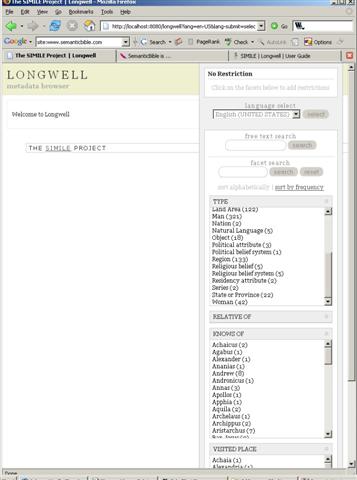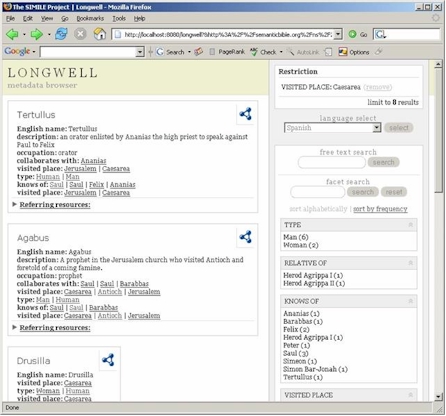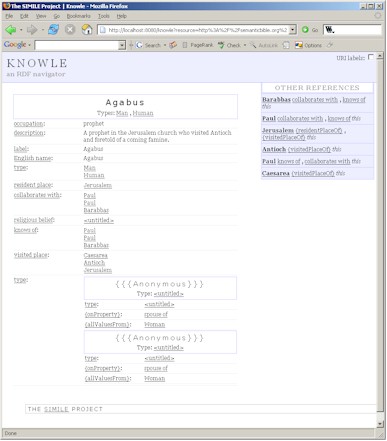... and then Stephen, the ever-helpful webmaster for Crossway Bibles (which distributes the English Standard Version ), pointed me to the Logos blog, where they're showing graphical representations of family relationships from the Bible. Their use of color to indicate gender seems effective, though the layout isn't immediately understandable (looks a little like the output of GraphViz).
So there are some interesting things brewing in the intersection of visualization and Biblical studies, and i'd be excited to see more!
1:04:29 PM #
As i'm working on my talk for the SBL Nov 21 (details here), i was out googling visualization and gospel, and found some pointers to Anh Dang's Gospel Spectrum, a Flash-based visualization of a Gospel harmony. Anh was kind enough to write me earlier this year and ask for my feedback on her project: somehow i failed to blog it. AKMA has some typically interesting comments, both about the presentation but also about harmonies in general. In addition to playing with the Flash presentation, the background information here is a nice overview of Gospel harmonies and how the church has dealt with "visual culture".
The possibilities of dynamic visualization were one of the main drivers for me in creating the Composite Gospel Index, though i haven't gotten as far there yet as i'd like. This has been an interest of mine for quite a while, and there will be more material about it coming out of my SBL talk, which will get posted to Blogos.
12:53:06 PM #
About a year and a half ago, when i got started on the New Testament Names, i was already thinking about how to present the information. It really is true that a picture is worth 1000 words (or at least some pictures), even though it's the data that's the critical treasure (and that's the hardest to mine).
Since i'm still trying to complete the data, that initial prototype never got off the ground. But in the interim, i found the Simile Project: included among several useful open source tools for semantic web stuff is Longwell, a "faceted meta-data browser". The basic idea is that you configure which classes and properties you want to display (the facets), and how they're displayed. Longwell then presents the information, provides both free text search and faceted text search, as well as mechanisms to select data based on properties. (Ryan, if you're reading this, thanks for your work on such a great tool!)
But nits aside (i'm still figuring out all the configuration issues), this is a great way to get a real look at semantic web data, without creating a whole custom app. I've already found a number of bugs that you just don't notice when you're looking at lots of pointy brackets (raw OWL) or complex tabbed interfaces (Protege).
The only bad news is that the hosting service i use for SemanticBible doesn't let me run Jetty, the open source Java web server Longwell's built on. So i don't (yet) have any way to make this kind of brower display available to others: it's just a desktop app. I'll keep thinking about this while i try to get NTN finished up in time for the Society for Biblical Literature conference next month.
12:18:02 PM #
 |
Unless otherwise noted, all content is copyright 2005 by Sean Boisen |
 Technorati Profile
Technorati Profile




